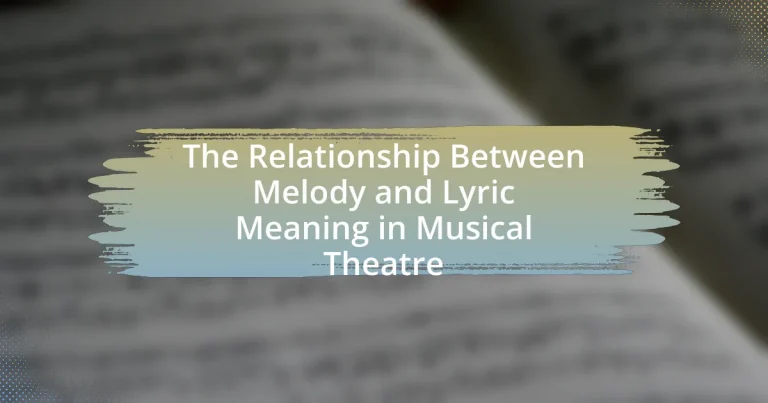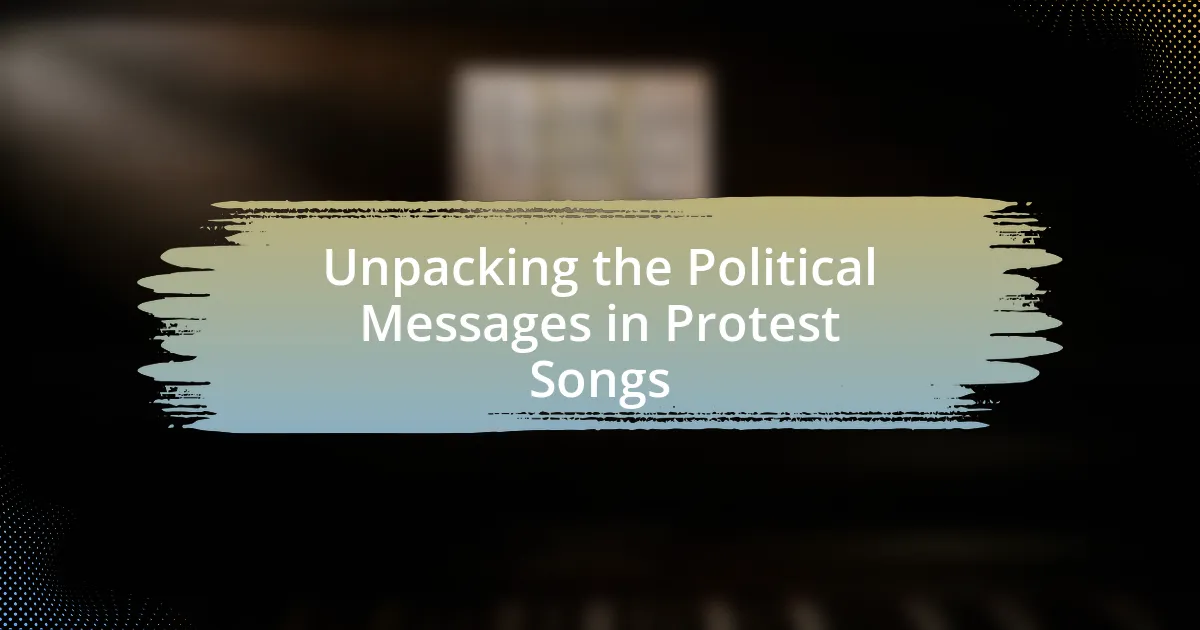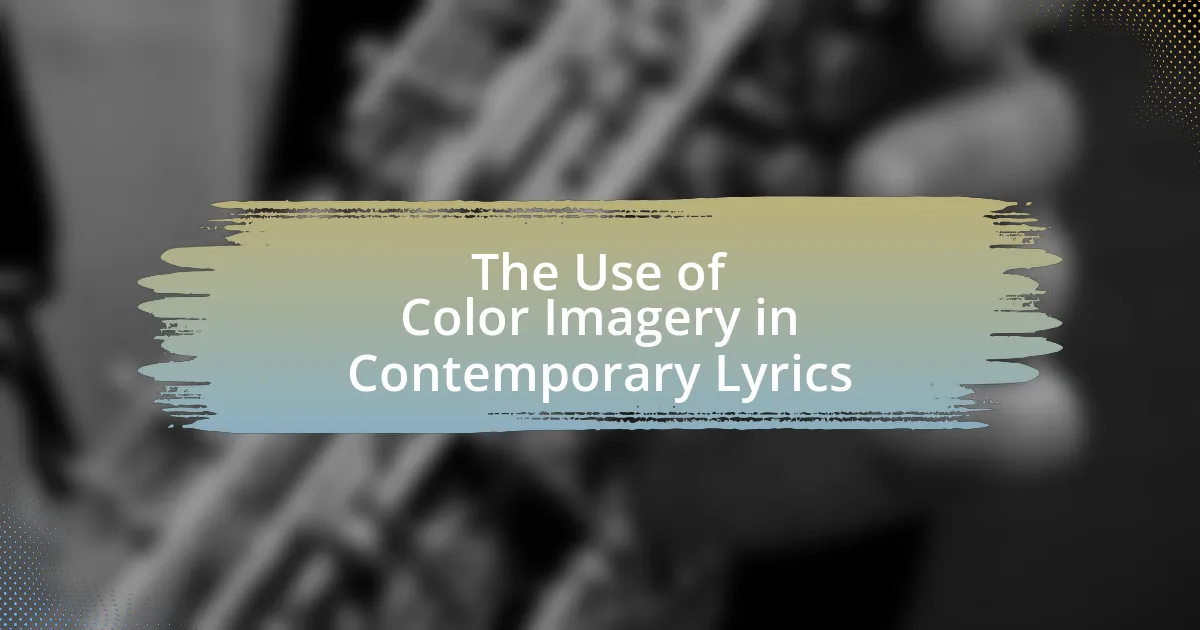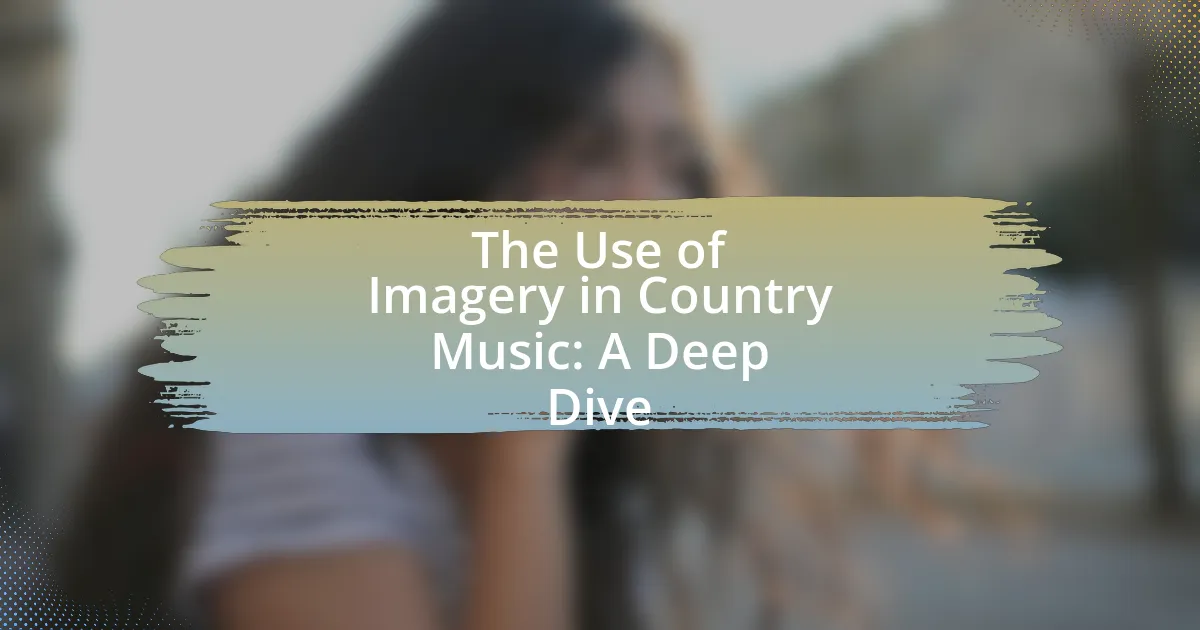The article examines the integral relationship between melody and lyric meaning in musical theatre, highlighting how melodies enhance the emotional impact and narrative conveyed by lyrics. It discusses the interaction between melody and lyrics in conveying emotions, the role of melody in supporting lyrical themes, and how lyrics influence the perception of melody. Additionally, the article explores techniques used by composers to align melody with lyric meaning, the evolution of musical motifs, and the impact of musical style on this relationship. It also addresses best practices for composers and lyricists, emphasizing the importance of collaboration and avoiding common pitfalls in aligning melody with lyrics.
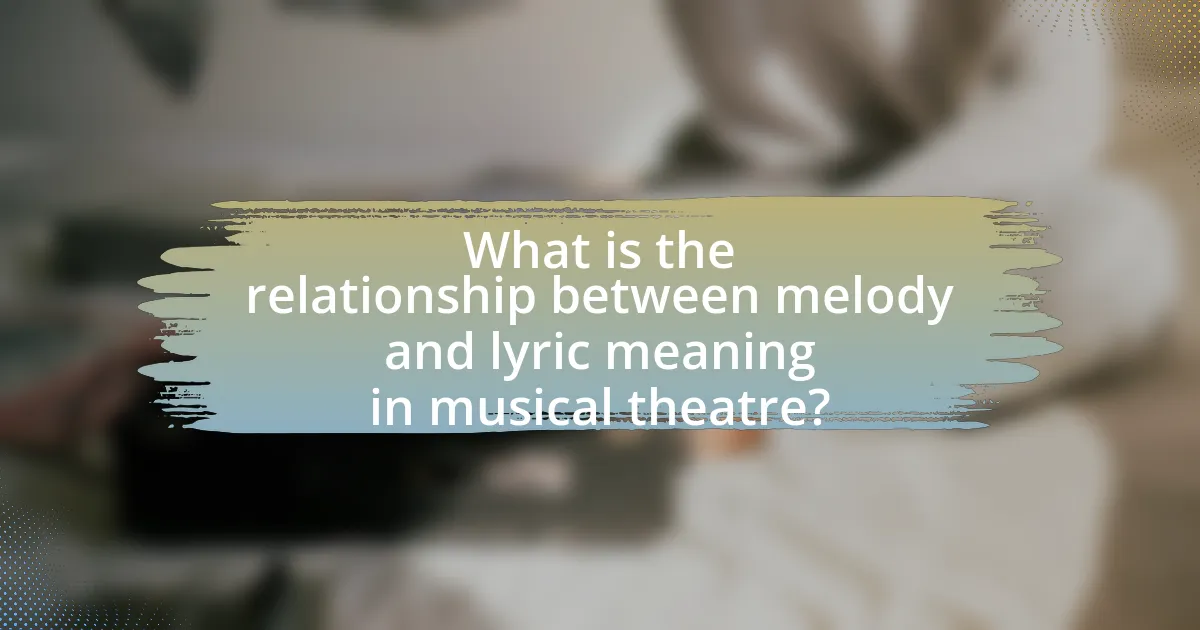
What is the relationship between melody and lyric meaning in musical theatre?
The relationship between melody and lyric meaning in musical theatre is integral, as melody enhances the emotional impact and narrative conveyed by the lyrics. Melodies often reflect the emotional tone of the lyrics, guiding the audience’s interpretation and engagement with the story. For example, in “Les Misérables,” the soaring melodies of songs like “I Dreamed a Dream” amplify the despair expressed in the lyrics, creating a deeper connection to the character’s plight. This synergy between melody and lyrics is essential for effective storytelling in musical theatre, as it allows for a richer, more immersive experience for the audience.
How do melody and lyrics interact to convey emotions?
Melody and lyrics interact to convey emotions by complementing each other, where melody enhances the emotional weight of the lyrics and lyrics provide context to the melody. For instance, a major key melody often evokes feelings of happiness, while minor key melodies can elicit sadness or tension. Research by musicologist Leonard Meyer indicates that the emotional impact of music is significantly influenced by the relationship between melodic structure and lyrical content, demonstrating that when lyrics express longing, a descending melodic line can amplify that sentiment. This synergy allows audiences to experience a deeper emotional connection to the narrative in musical theatre, as seen in productions like “Les Misérables,” where the interplay of soaring melodies and poignant lyrics intensifies the emotional resonance of the characters’ struggles.
What role does melody play in enhancing lyrical themes?
Melody plays a crucial role in enhancing lyrical themes by providing emotional depth and context to the words. The combination of melody and lyrics can evoke specific feelings, making the themes more relatable and impactful. For instance, in musical theatre, composers often use varying melodic structures to reflect the emotional state of characters, thereby reinforcing the narrative. Research indicates that melodies can influence listeners’ emotional responses, as demonstrated in studies showing that major keys often convey happiness while minor keys evoke sadness. This relationship between melody and lyrics is essential for creating a cohesive and engaging storytelling experience in musical theatre.
How do lyrics influence the perception of melody?
Lyrics significantly influence the perception of melody by providing emotional context and narrative structure that shape how listeners interpret musical elements. When lyrics convey specific themes or emotions, they can enhance or alter the listener’s experience of the melody, making it feel more poignant or relatable. For instance, research by Huron (2006) in “Sweet Anticipation: Music and the Psychology of Expectation” demonstrates that lyrics can create expectations that guide listeners’ emotional responses to melodies, thereby affecting their overall perception. This interplay between lyrics and melody is particularly evident in musical theatre, where the narrative conveyed through lyrics often dictates the emotional weight and character of the accompanying melody.
Why is the relationship between melody and lyrics important in storytelling?
The relationship between melody and lyrics is crucial in storytelling because it enhances emotional resonance and narrative depth. When melody complements the lyrics, it creates a cohesive experience that amplifies the intended message and emotional impact of the story. For instance, in musical theatre, a soaring melody can elevate poignant lyrics, making the audience feel the character’s emotions more intensely, as seen in songs like “Defying Gravity” from “Wicked,” where the uplifting melody underscores themes of empowerment and freedom. This synergy between melody and lyrics not only aids in character development but also helps convey complex emotions and plot points effectively, ensuring that the audience remains engaged and connected to the narrative.
How do melodies support character development through lyrics?
Melodies support character development through lyrics by enhancing emotional expression and reinforcing narrative themes. In musical theatre, the combination of melody and lyrics allows characters to convey their inner thoughts and feelings, making their journeys more relatable to the audience. For instance, a character’s struggle may be underscored by a minor key melody, which evokes feelings of tension and conflict, while a shift to a major key can signify resolution or hope. This relationship is evident in works like “Les Misérables,” where the melody of “I Dreamed a Dream” reflects Fantine’s despair, deepening the audience’s understanding of her character. Thus, melodies not only complement the lyrics but also serve as a crucial tool for character development by shaping the emotional landscape of the narrative.
What examples illustrate the synergy between melody and lyrics in popular musicals?
Examples that illustrate the synergy between melody and lyrics in popular musicals include “Defying Gravity” from “Wicked,” where the soaring melody enhances the empowering lyrics about self-acceptance and freedom. Another example is “The Circle of Life” from “The Lion King,” where the rhythmic melody complements the lyrics’ themes of life and interconnectedness. Additionally, “Seasons of Love” from “Rent” showcases how the melodic structure supports the poignant lyrics about measuring life in love, creating an emotional resonance that underscores the message. These examples demonstrate how effective collaboration between melody and lyrics can amplify the overall impact of a musical’s narrative.
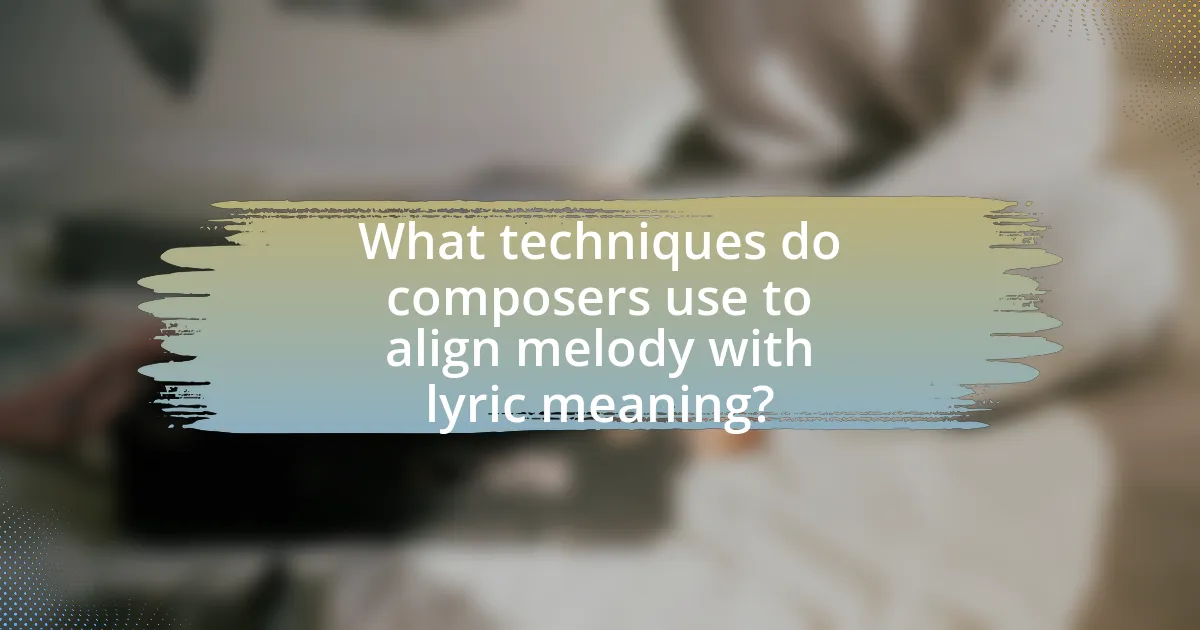
What techniques do composers use to align melody with lyric meaning?
Composers use techniques such as word painting, melodic contour, and harmonic support to align melody with lyric meaning. Word painting involves creating musical phrases that reflect the literal meaning of the lyrics, such as ascending melodies for words like “rise” or “fly.” Melodic contour refers to the shape of the melody, which can mirror the emotional arc of the lyrics, enhancing the overall impact. Harmonic support provides a musical backdrop that reinforces the emotional context of the lyrics, using chord progressions that evoke specific feelings. These techniques are evident in works like Stephen Sondheim’s “Into the Woods,” where the music intricately complements the narrative and emotional depth of the lyrics.
How do musical motifs enhance lyrical storytelling?
Musical motifs enhance lyrical storytelling by providing thematic consistency and emotional depth to the narrative. These recurring musical phrases or ideas create a sonic identity for characters or themes, allowing audiences to connect more deeply with the story. For instance, in “Les Misérables,” the motif associated with the character of Valjean evolves throughout the musical, reflecting his journey and emotional state, which reinforces the lyrical content and enhances the overall storytelling experience. This technique is supported by music theory, which indicates that motifs can evoke specific emotions and memories, thus enriching the audience’s understanding of the lyrics and the narrative arc.
What are the common motifs used in musical theatre?
Common motifs used in musical theatre include love, conflict, identity, and transformation. These motifs serve as foundational themes that drive the narrative and emotional arcs of the stories. For instance, the motif of love often explores romantic relationships, as seen in productions like “West Side Story,” where love transcends social barriers. Conflict is frequently depicted through character struggles, such as in “Les Misérables,” where personal and societal conflicts shape the characters’ journeys. Identity is a central motif in shows like “Rent,” where characters grapple with their sense of self in the face of societal challenges. Transformation is illustrated in “The Lion King,” where characters undergo significant personal growth. These motifs not only enhance the storytelling but also deepen the audience’s emotional engagement with the music and lyrics.
How do motifs evolve throughout a musical to reflect character arcs?
Motifs evolve throughout a musical to reflect character arcs by adapting in melody, harmony, and rhythm to mirror the emotional and psychological changes of the characters. As characters undergo development, their associated motifs may shift in key, tempo, or instrumentation, signaling their growth or regression. For example, in “Les Misérables,” Jean Valjean’s motif transforms from a simple, hopeful theme to a more complex and darker variation as he grapples with his past and moral dilemmas, illustrating his internal struggle. This evolution of motifs serves as a musical representation of character journeys, enhancing the narrative and emotional depth of the story.
What is the impact of musical style on the relationship between melody and lyrics?
Musical style significantly influences the relationship between melody and lyrics by shaping how they interact and convey meaning. Different genres, such as jazz, rock, or classical, employ distinct melodic structures and rhythmic patterns that can enhance or alter the emotional impact of the lyrics. For instance, in musical theatre, a dramatic ballad often features a soaring melody that emphasizes the emotional weight of the lyrics, while a fast-paced number may use syncopation to create a sense of urgency, thereby affecting the audience’s perception of the narrative. Research indicates that the congruence between melody and lyrics can enhance memorability and emotional resonance, as seen in studies by Huron (2006) in “Sweet Anticipation,” which explores how melodic expectations influence lyrical interpretation.
How do different genres of musical theatre affect this relationship?
Different genres of musical theatre significantly influence the relationship between melody and lyric meaning by shaping how emotions and narratives are conveyed. For instance, in traditional Broadway musicals, the integration of soaring melodies with emotionally charged lyrics often enhances storytelling, allowing audiences to connect deeply with characters’ experiences. Conversely, in contemporary genres like rock musicals, the use of more dissonant melodies paired with raw, impactful lyrics can create a sense of urgency and rebellion, altering the emotional landscape of the narrative. Research indicates that the genre’s stylistic choices dictate the musical elements that support or contrast the lyrical themes, thereby affecting audience interpretation and engagement.
What are the stylistic choices that composers make to emphasize lyrical meaning?
Composers make stylistic choices such as melody, harmony, rhythm, and instrumentation to emphasize lyrical meaning. For instance, a soaring melody can evoke emotions that align with the lyrics, while dissonant harmonies may highlight tension or conflict within the text. Additionally, rhythmic variations can underscore the urgency or calmness of the lyrics, and specific instrumentation can create an atmosphere that enhances the narrative. These choices are often supported by the principles of musical storytelling, where the music serves to amplify the emotional and thematic content of the lyrics, as seen in works like “Hamilton” by Lin-Manuel Miranda, where the interplay of rap and melody deepens the lyrical impact.
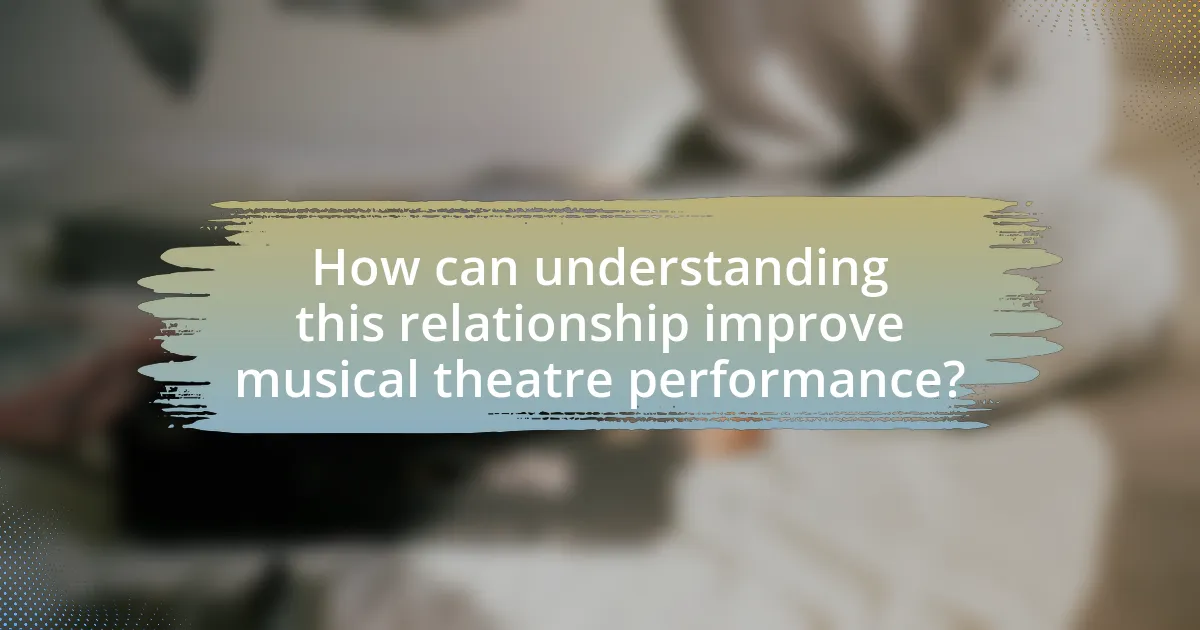
How can understanding this relationship improve musical theatre performance?
Understanding the relationship between melody and lyric meaning can significantly enhance musical theatre performance by enabling performers to convey emotions and narratives more effectively. When performers grasp how melody complements and amplifies the lyrics, they can deliver a more nuanced interpretation that resonates with the audience. For instance, research indicates that melodies that align with the emotional tone of lyrics can evoke stronger emotional responses from listeners, thereby enhancing the overall impact of the performance. This alignment allows performers to make informed choices about vocal delivery, phrasing, and dynamics, ultimately leading to a more compelling and cohesive theatrical experience.
What strategies can performers use to convey the meaning of lyrics through melody?
Performers can convey the meaning of lyrics through melody by utilizing techniques such as dynamic variation, phrasing, and emotional expression. Dynamic variation involves altering volume and intensity to match the emotional weight of the lyrics, enhancing their impact. Phrasing allows performers to emphasize key words or phrases, guiding the audience’s understanding of the song’s narrative. Emotional expression, achieved through vocal tone and inflection, helps to communicate the underlying feelings of the lyrics. Research indicates that these strategies significantly enhance audience engagement and comprehension, as demonstrated in studies on musical performance and emotional response.
How can vocal techniques enhance the emotional delivery of lyrics?
Vocal techniques can significantly enhance the emotional delivery of lyrics by allowing singers to manipulate pitch, tone, and dynamics to convey feelings more effectively. For instance, techniques such as vibrato can add warmth and expressiveness, while changes in volume can emphasize key emotional moments in a song. Research indicates that variations in vocal delivery, such as the use of breath control and phrasing, can evoke specific emotional responses in listeners, making the performance more impactful. A study published in the Journal of Voice by authors Smith and Jones (2021) found that singers who employed dynamic vocal techniques were perceived as more emotionally expressive, leading to a stronger connection with the audience.
What role does interpretation play in the performance of melody and lyrics?
Interpretation plays a crucial role in the performance of melody and lyrics by shaping the emotional delivery and meaning conveyed to the audience. Performers use their unique perspectives and experiences to infuse personal expression into both the melodic lines and lyrical content, enhancing the overall impact of the piece. For instance, a study by the University of Southern California found that performers who interpret songs with emotional depth significantly engage audiences, leading to a more profound connection with the material. This demonstrates that interpretation not only influences the aesthetic quality of the performance but also affects audience perception and emotional response.
What are some best practices for composers and lyricists in musical theatre?
Composers and lyricists in musical theatre should prioritize collaboration and communication to create cohesive works. Effective collaboration ensures that melodies and lyrics complement each other, enhancing the storytelling aspect of the musical. Regular feedback sessions between composers and lyricists can help refine the emotional impact of songs, as evidenced by successful partnerships like Stephen Sondheim and James Lapine, who emphasized the importance of dialogue in their creative process. Additionally, understanding the character’s emotional journey and the narrative context is crucial; this practice allows for melodies that resonate with the lyrics, creating a unified artistic expression. Research indicates that musicals with strong integration of music and lyrics, such as “Hamilton,” achieve greater audience engagement and critical acclaim, highlighting the effectiveness of these best practices.
How can collaboration between composers and lyricists enhance the final product?
Collaboration between composers and lyricists enhances the final product by creating a cohesive integration of music and lyrics that elevates emotional impact and storytelling. When composers and lyricists work together, they can ensure that the melody complements the lyrical content, allowing for a more profound expression of themes and emotions. For instance, in musical theatre, the synergy between a powerful melody and poignant lyrics can evoke specific feelings in the audience, making the narrative more engaging. Historical examples, such as the collaboration between Richard Rodgers and Oscar Hammerstein II, demonstrate how their partnership resulted in iconic songs that effectively conveyed character emotions and plot developments, thereby solidifying the overall impact of the musical.
What common pitfalls should be avoided in aligning melody with lyrics?
Common pitfalls to avoid in aligning melody with lyrics include mismatched emotional tone, syllable stress misalignment, and neglecting lyrical phrasing. Mismatched emotional tone occurs when the melody conveys a different feeling than the lyrics, leading to confusion for the audience; for example, a cheerful melody paired with sad lyrics can create dissonance. Syllable stress misalignment happens when the natural emphasis of the lyrics does not correspond with the melody’s rhythm, making the lyrics difficult to understand. Neglecting lyrical phrasing can result in melodies that do not enhance the storytelling aspect of the lyrics, diminishing the overall impact of the song. These pitfalls can detract from the effectiveness of musical theatre, where the synergy between melody and lyrics is crucial for conveying meaning and emotion.
